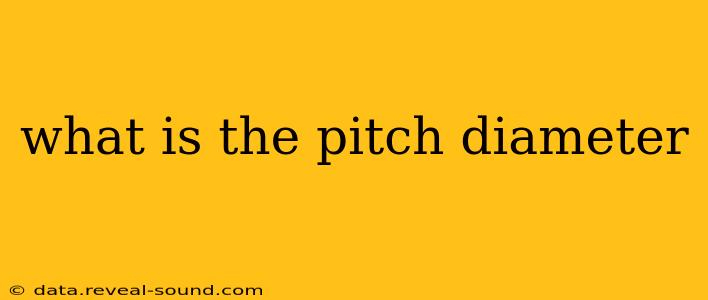The pitch diameter is a crucial measurement in mechanical engineering, specifically when dealing with threaded fasteners like screws, bolts, and nuts. Understanding this diameter is essential for calculating thread engagement, ensuring proper fit, and preventing mechanical failure. Simply put, the pitch diameter represents the diameter of an imaginary cylinder that would pass through the threads at the point where the width of the thread groove equals the width of the thread crest. It's not a directly measurable dimension like the major or minor diameter, but rather a calculated value derived from those measurements.
How is the Pitch Diameter Calculated?
The precise calculation of the pitch diameter depends on the thread profile (e.g., Acme, trapezoidal, square, or the common metric and Unified threads). For the commonly encountered ISO metric threads and Unified National Coarse (UNC) and Fine (UNF) threads, the calculation is based on the major diameter (the largest diameter of the thread) and the pitch (the distance between corresponding points on adjacent threads). While there are specific formulas that incorporate these parameters and consider thread profile specifics, they are often handled using pre-calculated tables or readily available software in engineering applications.
Many mechanical engineering handbooks provide extensive tables showing the pitch diameter for various standard thread sizes. These tables eliminate the need for complex calculations and ensure accuracy.
What is the difference between Pitch Diameter, Major Diameter, and Minor Diameter?
To fully grasp the pitch diameter, it's essential to understand its relationship to the major and minor diameters.
-
Major Diameter: This is the largest diameter across the threads, measured from the outermost points of the thread crests. It's the largest overall dimension of the threaded component.
-
Minor Diameter: This is the smallest diameter across the threads, measured from the innermost points of the thread roots. It represents the shaft or core diameter of the threaded component.
-
Pitch Diameter: As explained above, it's an intermediate diameter, representing the theoretical cylinder that passes through the threads at a point where the thread width equals the groove width. It’s crucial for determining proper engagement and load distribution in threaded connections.
Why is the Pitch Diameter Important?
The pitch diameter is critical for several reasons:
-
Accurate Thread Engagement: It ensures proper mating between threaded components, ensuring complete thread engagement and minimizing stress concentration. Incorrect pitch diameter can lead to poor fit, stripping, or failure.
-
Load Distribution: It directly influences the load distribution across the threads, ensuring even stress distribution and maximizing the strength of the connection.
-
Measurement and Inspection: It’s a key parameter used in thread inspection and quality control to ensure threads conform to specifications.
How to measure Pitch Diameter?
While not directly measurable with a simple caliper, the pitch diameter is indirectly determined through measurements of the major and minor diameters, and the pitch. Specialized tools and techniques are sometimes employed for precise pitch diameter determination. For most applications, referring to standardized tables or using appropriate software is sufficient.
What are some common applications of understanding pitch diameter?
Understanding pitch diameter is crucial in various applications:
-
Fastener Selection: Choosing the right fastener for an application requires careful consideration of the pitch diameter to ensure proper fit and strength.
-
Manufacturing: In manufacturing threaded components, precise control of the pitch diameter is vital to ensure proper functionality and interchangeability.
-
Design Engineering: Accurate calculation and specification of the pitch diameter are critical in designing reliable and efficient mechanical systems.
This detailed explanation provides a comprehensive understanding of the pitch diameter, its importance, and its relationship to other crucial threaded component measurements. Remembering that it's a calculated, not directly measured, dimension is key to its proper application.
